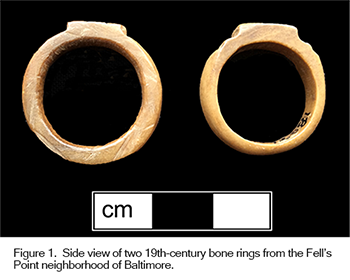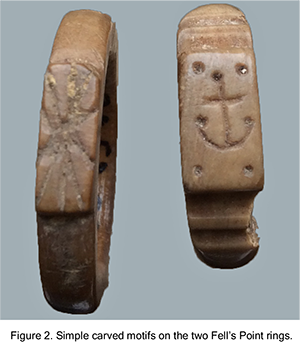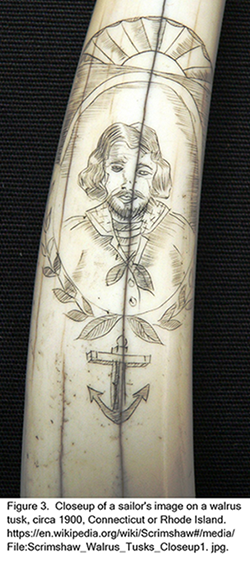Curator's Choice 2019
The Accessorized Mariner
November 2019
By Patricia Samford, MAC Lab, Director
 The human desire for adornment can be traced at least as far back as 40,000 years ago, when Neandertals inhabited Europe. Scientists excavating caves where Neandertals lived have discovered carved and polished teeth from mammoth and other animals that appear to have been worn as pendants. Since it was easily workable, bone was used by prehistoric peoples to create all manners of personal adornment items, including beads, gorgets, pendants and rings.
The human desire for adornment can be traced at least as far back as 40,000 years ago, when Neandertals inhabited Europe. Scientists excavating caves where Neandertals lived have discovered carved and polished teeth from mammoth and other animals that appear to have been worn as pendants. Since it was easily workable, bone was used by prehistoric peoples to create all manners of personal adornment items, including beads, gorgets, pendants and rings.
The two bone finger rings shown in Figure 1
are, however, of much more recent origin. 
They were found in the fill of a wood-lined trash pit at the Queen Street Lot 23 archaeological site (18BC52) in Baltimore. The pit was located in the rear yard of a late 18th- to early 19th-century brick rowhouse along South Bond Street in the Fells Point district of the city. Other artifacts found with the rings included ceramics dating from the second quarter of the ninteenth century, so it is likely these rings date to the same time period.
The rings each display a similar overall style, containing a flat rectangular face with a simple carved design. One displays a star or asterisk motif, while the other is decorated with an anchor framed with four dots (Figure 2). The latter ring is more skillfully finished, with a stepped profile and a nicely polished band. The star on the other ring is more crudely carved and the band still bears what appears to be scratches and scarring from the knife used to make the ring (Figure 1).
 The anchor design, as well as the site’s location in the Fell’s Point neighborhood of Baltimore – a prime shipbuilding area in the city—suggests that these rings may have been carved by a sailor. This idea is further supported by the history of the property where the rings were discovered. One of the lot’s first owners was mariner George Wells, whose tenure fell during the late 18th century. During his ownership, the lot at 854 South Bond Street was the site of the London Coffee House – the earliest coffee house in Baltimore. Similar to a tavern, the establishment likely attracted the business of sailors. The adjoining property was owned by a shipbuilder who operated an inn on the premises until around 1810. Nicholas Stansbury, a ship chandler (someone who sells supplies and equipment for ships) by trade, lived at 856 South Bond Street lot in the early 19th century (Etherton 1994).
The anchor design, as well as the site’s location in the Fell’s Point neighborhood of Baltimore – a prime shipbuilding area in the city—suggests that these rings may have been carved by a sailor. This idea is further supported by the history of the property where the rings were discovered. One of the lot’s first owners was mariner George Wells, whose tenure fell during the late 18th century. During his ownership, the lot at 854 South Bond Street was the site of the London Coffee House – the earliest coffee house in Baltimore. Similar to a tavern, the establishment likely attracted the business of sailors. The adjoining property was owned by a shipbuilder who operated an inn on the premises until around 1810. Nicholas Stansbury, a ship chandler (someone who sells supplies and equipment for ships) by trade, lived at 856 South Bond Street lot in the early 19th century (Etherton 1994).
Sailors have long been documented as crafting items from bone and ivory to pass the time during long voyages. Sailors on whaling ships had ready access to bones and teeth of these marine mammals and perfected the art of scrimshaw, or scrollwork, engravings, and carvings done in bone or ivory (Figure 3). Pie crimpers, combs, corset busks and similar items were likely made as gifts for loved ones back home (Malley 1983).
| References |
|
Etherton, Kevin
|
| 1994 |
An Archival Investigation of Cultural Resources Associated with Captain Wells' House and the London Coffee House, Fells Point, Baltimore, Md. BCUA Research Series No. 48. Report on file at MAC Lab
|
| |
Malley, Richard C.
|
| 1983 |
Graven by the fishermen themselves; Scrimshaw in Mystic Seaport Museum. Mystic Seaport Museum, Inc., Mystic Connecticut.
|
| |
|
| |